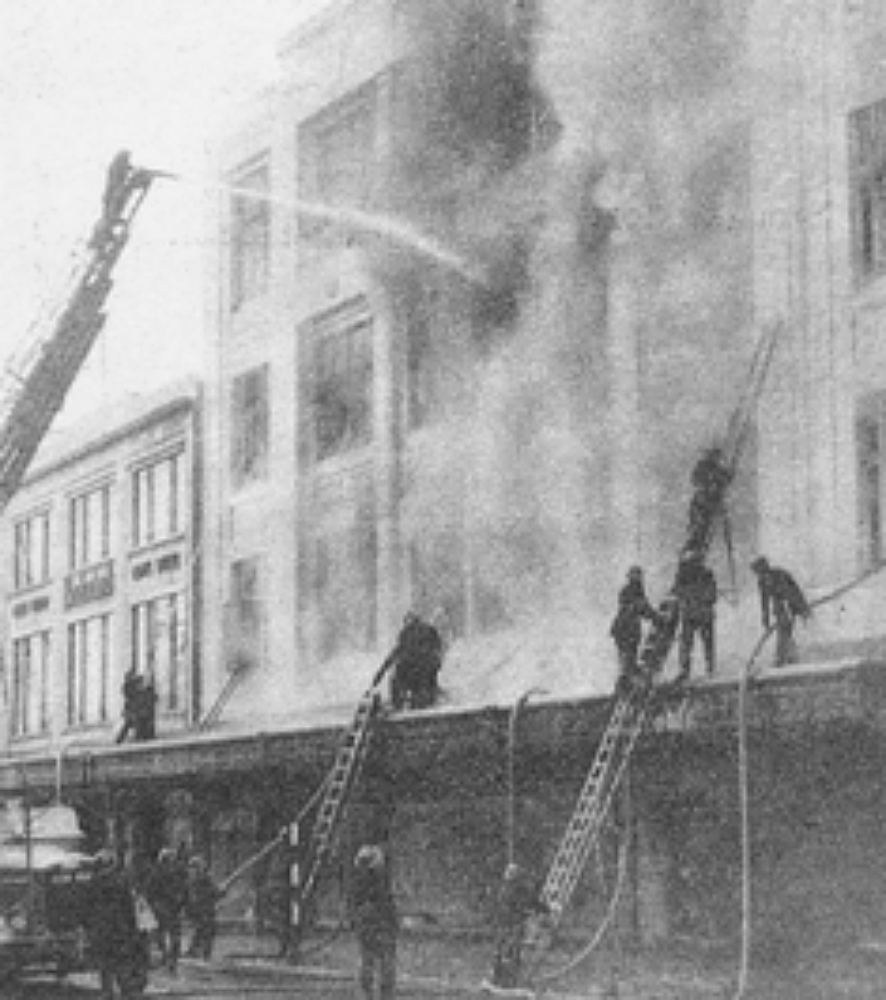Fire!

To say Worthing’s first fire engine was a primitive machine would be an overstatement. Donated by a local resident, Benjamin Hawes, it was kept hidden away in a dilapidated shed in Cook’s Row, a muddy lane off today’s Chatsworth Road. On the few occasions it was called to duty it relied on the strength of the entire voluntary fire brigade (of three and sometimes four men) for both motive power and operation.
Minimal use enabled it to survive for 26 years before being replaced by a Tilley fire engine (now in Worthing Museum) that served for 14 years. Not until 1855 did the newly appointed Town Board create the town’s first official fire brigade of one superintendent, 28 men and, eventually, three depots and three horse-drawn fire engines.
IN the following 154 years, Worthing suffered 11 fires categorised as “major.” They included Colonnade House, on the corner of the High Street and Warwick Street (August 1888), Goring Hall (1890), the Royal Seahouse Hotel (1901), Worthing Pier (1933), the Rivoli Cinema (1960) and Warnes Hotel (1987).
But it was on a balmy August morning in 1947 that Worthing Fire Brigade fought its greatest battle and proved its value to be beyond price when it saved the entire centre of Worthing from destruction.
It was a Miss Jackson, who worked in the soft furnishing department of the impressive Hubbard’s department store, who gave the alarm.
Awakened by a warm breeze rustling the curtains of Waterloo House, in Bedford Row, where she and several other Hubbard’s employees had lodgings, Miss Jackson heard the scary sound of crackling outside the window.
She ran to wake the housekeeper, Miss O’Brien, and together they peered from their window towards the rear of Hubbard’s.
To their horror they saw flames flickering behind one of the store’s first-floor windows.
As Worthing firemen spend through the deserted streets, police were warning the owners of all shops in the town centre to report to their premises.
They had quickly realised that if the fire gained a hold in the substantial Hubbard’s store, strategically situated between the main town centre shops and many of the town’s oldest properties, it might quickly devour a vast area of South Street, Warwick Street, Montague Street and even Chapel Road.
As the flames continued to spread, alarm bells clanged in every fire station in Sussex.
Worthing residents and holidaymakers were awakened as dawn broke by the clamour of bells from fire appliances converging on Worthing from Brighton, East Preston, Findon, Bognor Regis, Chichester, Littlehampton, Storrington, Lancing, Arundel, Henfield, Guildford, Crawley and the Woking area of the Area Fire Fighting Force.
Never before had so many fire engines been called in from over such a wide area, as flames mushroomed into the air after shattering the glass dome on Hubbard’s roof.
But for the skill of Worthing’s firemen in tackling the inferno and local fire chiefs directing the encirclement of Hubbard’s with walls of water, Worthing town centre could have been devastated.
By nine o’clock that morning the fire was officially under control, in its wake the gutted shell of the Hubbard’s store at first, second and third-floor levels.
Final cost of the blaze was estimated to be £240,000. It might seem a paltry sum by today’s values but the was 1947. It was put into context by the official report revealing the Hubbard’s fire to be the second biggest incident of its kind in the entire country during that August.
If a stiff breeze had been blowing that day (as it is in Worthing on so many days of the year) the town’s entire main shopping area could have become involved, with catastrophic results.
In the event, the store was rebuilt and today it houses Debenhams.